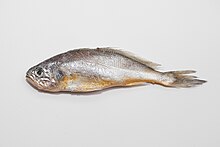| Larimichthys polyactis | |
|---|---|

| |
| Scientific classification | |
| Domain: | Eukaryota |
| Kingdom: | Animalia |
| Phylum: | Chordata |
| Class: | Actinopterygii |
| Order: | Acanthuriformes |
| Family: | Sciaenidae |
| Genus: | Larimichthys |
| Species: | L. polyactis |
| Binomial name | |
| Larimichthys polyactis (Bleeker, 1877) | |
| Synonyms | |
| |
Larimichthys polyactis, called the redlip croaker, small yellow croaker, little yellow croaker or yellow corvina, is a species of croaker native to the western Pacific, generally in temperate waters such as the East China Sea and the Yellow Sea.
Evolution
Main article: Evolution of fishPhylogenomic studies indicate this species emerged from the same common ancestor of L. crocea around 25.4 million years ago.
Diet
They are benthopelagic feeders that usually eat shrimp, zooplankton, or sometimes small fishes.
Habitat
They remain in shallow waters above 120 m, but avoid brackish conditions. They are typically found where the sea floor is sand or mud.
Morphology
Males can reach 42 cm while the common length is about 30 cm. Their body shape is almost rectangular. They have red lips, grey gold body, gold belly and light yellow fins. The inside of its mouth is white and the gill slit is black. In its head are two hard, pale, white bones that keep balance when they swim, which is also used as a material for medicine. They can make noise by moving their air bladder in order not to scatter.
Behavior
They have a habit of leaping above the sea. In winter, they move to warm water. The breeding season is from March to June. Usually they spawn 30,000 ~ 70,000 eggs.
Relation to humans

Once an abundant commercial fish off the coasts of China, Korea and Japan, its population collapsed in the 1970s due to overfishing. Global catch later rebounded, with 388,018 t landed in 2008. Salted and dried, they are a food product known as gulbi (굴비) in Korean. Yeonggwang gulbi is a prized delicacy, selling for over $100 a bunch.
References
- Froese, Rainer; Pauly, Daniel (eds.). "Larimichthys polyactis". FishBase. February 2023 version.
- Chai, J. Y.; Chu, Y. M.; Sohn, W. M.; Lee, S. H. (June 1986). "Larval anisakids collected from the yellow corvina in Korea". Kisaengchunghak Chapchi. 24 (1): 1–11. doi:10.3347/kjp.1986.24.1.1. PMID 12886102.
- Xie, Qing-Ping; Zhan, Wei; Shi, Jian-zhi; Liu, Feng; Niu, Bao-Long; He, Xue; Liu, Meng; Liang, Qiqi; Xie, Yue; Xu, Peng; Wang, Xu (2021-08-02). "Whole-genome assembly and annotation of little yellow croaker (Larimichthys polyactis) provide insights into the evolution of hermaphroditism and gonochorism". Authorea Preprints. doi:10.22541/au.162790498.82247747/v1. S2CID 238843975.
- Xie, Qing-Ping; Zhan, Wei; Shi, Jian-Zhi; Liu, Feng; Niu, Bao-Long; He, Xue; Liu, Meng; Wang, Jing; Liang, Qi-Qi; Xie, Yue; Xu, Peng; Wang, Xu; Lou, Bao (2022). "Whole-genome assembly and annotation for the little yellow croaker ( Larimichthys polyactis ) provide insights into the evolution of hermaphroditism and gonochorism". Molecular Ecology Resources. 23 (3): 632–658. doi:10.1111/1755-0998.13731. PMID 36330680.
- "Fisheries and Aquaculture - Global Production". Food and Agriculture Organization of the United Nations (FAO). Retrieved 2024-05-06.
- Orleans, Leo A., ed. (1980). Science in Contemporary China. Stanford University Press. p. 239. ISBN 978-0-8047-1078-7.
- "Larimichthys polyactis". Fisheries Global Information System. Food and Agriculture Organization of the United Nations. Retrieved 23 November 2010.
External links
- Froese, Rainer; Pauly, Daniel (eds.). "Larimichthys polyactis". FishBase. April 2010 version.
- "Larimichthys polyactis". Integrated Taxonomic Information System. Retrieved 23 November 2010.
| Taxon identifiers | |
|---|---|
| Larimichthys polyactis | |
| Pseudosciaena polyactis | |